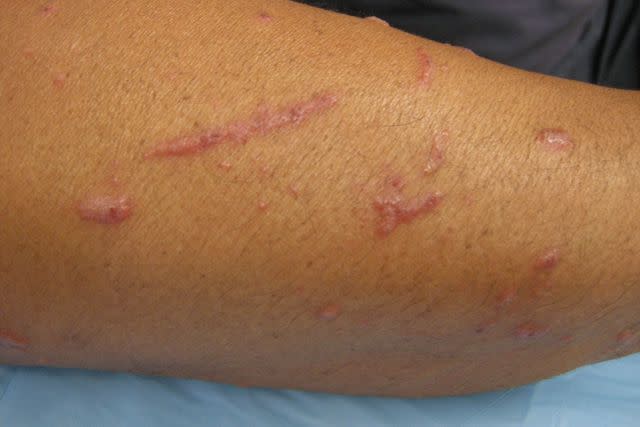What a Grass Rash Looks Like and How to Find Relief
Medically reviewed by Jurairat J. Molina, MDMedically reviewed by Jurairat J. Molina, MD
A grass rash occurs after the skin comes in contact with grass. It commonly results from a grass allergy, skin irritation, or contact dermatitis (a rash that develops from something irritating that contacts your skin) and affects people of all ages.
If you are allergic to grass or wonder why you get a rash when you sit on the grass, learning how to manage and prevent grass rashes is important.
This article explains the symptoms and causes of grass rash as well as treatment and when to see a healthcare provider for it.

Reproduced with permission from © DermNet dermnetnz.org 2023.
Plant dermatitis from contact with a rhus treeWhat Does a Grass Rash Look Like?
If you have a grass rash, you may notice a rash on whichever part of your body is in contact with grass. If you are lying in the grass, you may notice a rash on your face or a rash on your neck.
Typical symptoms experienced by individuals with grass rash include:
Some people experience red spots on their skin but are not itchy. This is less common, though. Most of the time, itching accompanies a grass rash.
Why Grass Can Cause a Rash
Various factors, including allergies, contact dermatitis, and other potential triggers, can contribute to developing a grass rash. Exposure to grass or grass-related allergens can cause a histamine response (chemicals in the body that communicate with the immune system), leading to a rash.
Grass Allergy
If you have a grass allergy, you are allergic to grass pollen. In addition to a rash, a grass allergy can lead to other body-wide symptoms, including:
Runny and stuffy nose
Postnasal drip (mucus that drips down the back of your throat)
Itching
Red, watery, swollen eyes
Mood changes
Trouble sleeping
Contact Dermatitis
Contact dermatitis can also cause a grass rash. Contact dermatitis occurs when your skin comes in contact with something that irritates you because of a sensitivity or allergy.
In addition to a skin rash, contact dermatitis can cause other symptoms, including:
Itching
Swelling
Fluid-filled blisters
Tender skin
Sensitive Skin
If you have sensitive skin, you may also experience a grass rash. People with sensitive skin develop a sensory reaction to certain environmental things. If you have grass rash caused by sensitive skin, you may also notice the following symptoms:
Pruritus (itching)
Skin burning
Skin tingling
Skin thickening
Skin dryness
Erythema (skin redness)
Papules (raised skin lesion)
Vesicles (blisters)
Grass Is Pokey (Skin Irritation)
You may experience grass rash because of skin irritation. Grass can be spiky, and so if you sit or lie on it, even if you don't have allergies or sensitive skin, it may still irritate your skin. That may be especially true if you are exposed to grass for an extended period.
How to Treat a Grass Rash: Home Remedies
How do you eliminate grass rash, and does Benadryl help with grass allergies? Many things can help, including Benadryl, especially if you experience other allergy symptoms.
Some home remedies to try include:
Over-the counter (OTC) remedies: oral antihistamines, nasal antihistamines
Steroids: topical steroid creams
Natural remedies: oatmeal bath, applying cold compresses, using soothing lotions or creams, and avoiding scratching
If the above at-home remedies don't work, you may benefit from prescription medications, like higher-strength antihistamines or steroids. Speak with a healthcare provider to learn about prescription medications for grass rash or allergic reactions.
How to Prevent a Grass Rash
The good news is that grass rash can be prevented effectively. Try the following practical tips on how to prevent grass rashes, especially for individuals with known allergies or sensitivities:
Limit outdoor time when pollen counts are high if you have a grass allergy.
Keep your lawn mowed short to make it less likely to release pollen.
Change and wash clothing to remove pollen.
Shower and wash hair after exposure.
Dry clothing in a dryer rather than on a clothesline.
If you don't have an allergy but have sensitive skin or contact dermatitis, you may want to avoid letting your exposed skin touch the grass. If you will be sitting on the grass, wear long pants, socks, and shoes. Better yet, avoid sitting directly on the grass. Instead, use a towel or blanket or sit in a chair. Barrier creams or lotions may also minimize skin irritation.
When to Contact a Healthcare Provider
Like other allergens, grass allergies tend to subside after you remove the exposure. That's why the best allergy management technique is avoidance.
Here is when to worry about rash in adults:
The rash covers most of your body.
The rash blisters.
You have open sores or raw skin.
You have a fever.
Your rash spreads rapidly.
Your rash is painful.
The rash involves the eyes, lips, mouth, or genitals.
Seek medical attention if you have known allergies or underlying health conditions.
Summary
A pollen allergy, sensitive skin, contact dermatitis, or skin irritation may cause grass rash. Fortunately, grass rash generally responds well to at-home treatments. You can prevent grass rash by avoiding exposure to grass on your bare skin and limiting time outdoors if you have a pollen allergy.
If your symptoms are persistent or extreme, see a healthcare provider for appropriate treatment for grass rashes. Usually, the rash will go away soon after you remove the irritant.
Read the original article on Verywell Health.
